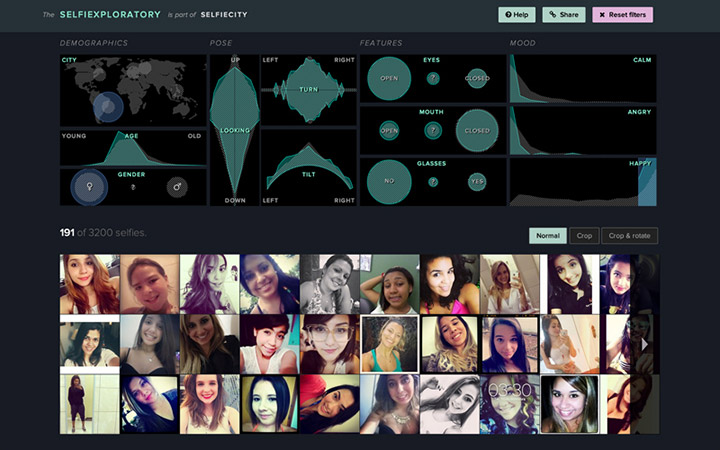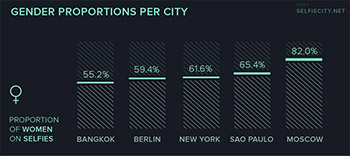Capturing the Zeitgeist: Exploring Urban Trends through Selfies
By:
- Doug Ramsey
Published Date
By:
- Doug Ramsey
Share This:
Article Content

Some of the selfies that explain why women in Sao Paulo smile in their self-portraits more than women (or men) in the other four cities studied.
The term ‘selfie’ took on a life of its own in 2013, especially after the Oxford English Dictionary selected it as the ‘international word of the year’. The Internet and mobile phones were awash in self-portraits as consumers purchased more smartphones with front-facing cameras – turning the selfie into a truly worldwide phenomenon. Now comes more evidence that selfies have come to inhabit a unique place in world culture – a place with a Web address of its own: Selfiecity.net.
A team of programmers, designers, media theorists and art historians from the Graduate Center, City University of New York (CUNY), the University of California, San Diego, and institutions in Germany used advanced media tools to parse the selfie phenomenon. Their findings went viral when they made their findings available and easily navigable at the interactive website, which allows viewers to visualize 3,200 Instagram selfies from five cities.
“We analyzed and visualized thousands of selfies from Instagram, comparing patterns across New York, Bangkok, Berlin, Moscow and São Paulo,” said CUNY computer science professor Lev Manovich, who leads the Selfiecity project as well as the Software Studies Initiative in the Qualcomm Institute at the University of California, San Diego. “We were able to create a rich project which combines innovative interactive visualization of the photo collection, research findings, and theoretical essays, and it is gratifying to see how the media and the public have responded.”
Selfiecity.net’s ease of use and eye-catching data visualizations mask what was a highly complex and multi-stage research project, starting with the collection of raw data. Using the social-data service Gnip, the team collected more than 650,000 Instagram photos that were uploaded over one week in December 2013. Researchers then selected random sets of 20,000 to 30,000 photos from each city which could contain possible selfies. At this point, Manovich and his colleagues outsourced much of the labor to Amazon’s Mechanical Turks crowdsourcing marketplace. The Turks were asked to pick out the true selfies (a self-portrait of one person only), and from those the project team settled on 640 selfies from each of the five cities. The Turks were then asked to estimate the age and gender of each person depicted. Each photo was evaluated by at least three workers.
From there, the researchers used stat-of-the-art computer vision software to analyze emotional cues, mood, facial positions, and other details of every face. The result is the Selfiexploratory section of the website, where the public can explore the selfies database using the results of this analysis, as well city, gender and age metadata.
“For the first time web visitors are able to explore interactively the thousands of images, sorting and filtering them and immediately seeing new results,” explained project leader Manovich. “This is a big step for us – bringing to the Web techniques for interactive exploration of media collections that we first developed for large-scale visualization walls at UC San Diego’s Qualcomm Institute.”
For the current phase of the project, the term ‘selfie’ was defined strictly as the photo of one person, taken by the same person using a mobile phone. Using a variety of tools, software developers produced visualizations based on facial recognition data, automated analysis of visual cues, and more.

Comparing the proportion of selfies featuring women in each city shows that the gender imbalance is greatest in Moscow.
Selfiecity’s intuitive and robust interface makes it easier for visitors to find very general information (e.g., age or gender distribution by city) as well as very granular information (drilling down into the database for information only on smiling women in New York who tilt their heads while wearing glasses).
The developers behind Selfiecity also wanted to provide statistical insight into trends that until now seemed purely subjective. “The idea was to confront the generalizations about selfies, which are not based on data, with actual data,” Manovich told Wired magazine. “We wanted to look at what the actual patterns are.”
For example, more women than men take selfies, but for people over the age of 30 the trend is reversed, with more men taking selfies. The median age of all subjects is 25 years old. Muscovites smile least, while selfie takers in Bangkok and São Paulo are more likely to flash a smile. And as the magazine Slate pointed out in its coverage of the study, a very popular angle of the head in a selfie is “the head tilt… clearly the definitive head angle of our time.” The study found that on average women tilt their heads 50 percent more often than men, and women in São Paulo tilt their heads nearly 17 degrees on average – more than in any other city surveyed. The researchers also analyzed other details of each selfie, such as whether the person was looking left or right, up or down, and so on.
One of the most surprising finding of the project to date, said Manovich, was an estimate of how many people take selfies. Despite the general impression that selfie-taking is rampant, the team found that only about four percent of Instagram photos would qualify as true selfies.
(This count does not include the increasingly popular ‘group’ selfie, such as Ellen DeGeneres’ famous photo tweeted from the 2014 Academy Awards. It was re-tweeted more than 3,200,000 times – a new world record – but would not be considered a selfie by this study, since Bradley Cooper, Meryl Streep and other high-octane stars crowded around the Oscar host for what is now narrowly defined as a group selfie.)
However they are defined, selfies are “an interesting thing to study right now," said Moritz Stefaner, Selfiecity’s lead information visualization designer, in an interview with Fast Company’s Co.Design website. "Are they just a fad, or do they represent a substantial new trend of how we create and share photos? Are they a means of self-expression, a tool of self-promotion, or a cry for attention? And are there any cultural differences in the way people in different countries take selfies?"
The Selfiecity.net team now consists of eight far-flung participants based in New York, San Diego and Europe. Project leader Lev Manovich leads the contingent in New York, where collaborators include: concept developer and ‘strategic interaction designer’ Daniel Goddemeyer; Nadav Hochman (a visiting researcher at CUNY who is a Ph.D. student at the University of Pittsburgh); and CUNY Ph.D. student Alise Tifentale, an art historian who contributed an essay on the selfie. (Writes Tifentaler: “The selfie is the vernacular of the 21st century.”) European partners include lead visualization designer Moritz Stefaner, and Dominikus Baur, who worked on the user interface and data visualization.
In San Diego, team members include (in addition to the bi-coastal Manovich) UC San Diego alumni Mehrdad Yazdani (Ph.D., ECE ’12) and Jay Chow (BA, ICAM ’12). Yazdani is a data scientist specializing in machine learning and data mining, and he handled data analysis for Selfiecity. Chow is a media design and programmer who develops tools for data collection and management, and also works on visualization. Both Yazdani and Chow are based in the Qualcomm Institute at UC San Diego.
Selfiecity is the second project developed by Manovich and his colleagues based on large collections of Instagram photos. In summer 2013, they released PhotoTrails, which provided rich visualizations based on an analysis of 2.3 million Instagram photos from 13 cities around the world.
Share This:
You May Also Like
Stay in the Know
Keep up with all the latest from UC San Diego. Subscribe to the newsletter today.



